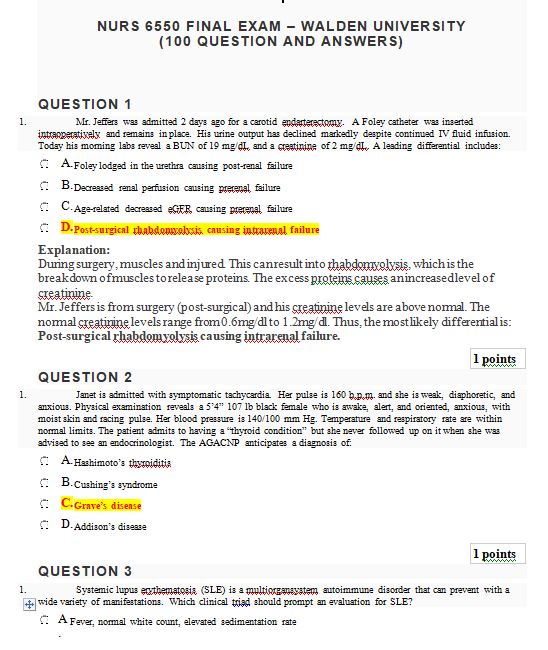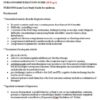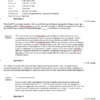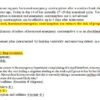Description
NURS 6550 FINAL EXAM – WALDEN UNIVERSITY
- Mr. Jeffers was admitted 2 days ago for a carotid endarterectomy. A Foley catheter was inserted intraoperatively and remains in place. His urine output has declined markedly despite continued IV fluid infusion. Today his morning labs reveal a BUN of 19 mg/dL and a creatinine of 2 mg/dL. A leading differential includes:
- Janet is admitted with symptomatic tachycardia. Her pulse is 160 b.p.m. and she is weak, diaphoretic, and anxious. Physical examination reveals a 5’4” 107 lb black female who is awake, alert, and oriented, anxious, with moist skin and racing pulse. Her blood pressure is 140/100 mm Hg. Temperature and respiratory rate are within normal limits. The patient admits to having a “thyroid condition” but she never followed up on it when she was advised to see an endocrinologist. The AGACNP anticipates a diagnosis of:
- Systemic lupus erythematosis (SLE) is a multiorgansystem autoimmune disorder that can prevent with a wide variety of manifestations. Which clinical triad should prompt an evaluation for SLE?
- A patient presents with profound vertigo of acute onset yesterday. She can barely turn her head without becoming very vertiginous; she is nauseous and just doesn’t want to move. This morning when she tried to get out of bed she felt like she was pushed back down. The vertigo is reproducible with cervical rotation. The patient denies any hearing loss or tinnitus, she has no fever or other symptoms. The AGACNP knows that the most helpful intervention will probably be:
- Mrs. Mireya is an 85-year-old female who is admitted for evaluation of acute mental status change from the long term care facility. She is normally ambulatory and participates in lots of facility activities. Today a nursing assistant found her in her room, appearing confused and disconnected from her environment. When she tried to get up she fell down. Her vital signs are stable excepting a blood pressure of 90/60 mm Hg. The AGACNP knows that the most likely cause of her symptoms is:
- A patient with SIADH would be expected to demonstrate which pattern of laboratory abnormalities?
- Sean is a 29-year-old male who presents to the emergency department for evaluation and treatment of foreign body in the eye. Ophthalmic anesthesia is achieved and removal is attempted unsuccessfully with a moist cotton tipped swab. A wet fluorescein stain is applied to the lower eyelid, and a corneal abrasion ruled out but the AGACNP notes a positive Seidel sign. This indicates:
- Mrs. Lowen is an 82-year-old female who comes to the emergency department for evaluation of a fever of 102.9° F. She complains of a headache in the right side of her temple and some right-sided jaw pain. A urinalysis, chest radiograph, complete blood count (CBC) and 12-lead ECG are all non-contributory. A comprehensive metabolic panel is significant only for a slightly elevated BUN and creatinine. The AGACNP appreciates distinct right temple tenderness to percussion. Which laboratory test is necessary to support the suspected diagnosis?
- Ms. Schiebel, a 31-year-old female who is brought to the emergency department by police after being arrested for disruptive behavior in a public establishment. The differential diagnosis includes drug and alcohol ingestion/toxicity, central nervous system disease, severe trauma, and psychotic illness; ultimately the alcohol and toxicology screen as well as head imaging are negative. When considering psychotic illness, the AGACP knows that this is a physiologic imbalance that typically involves an excess of:
- Mr. Lincoln is a 55-year-old male who was admitted for management of sepsis secondary to pneumonia. He has declined rapidly, and today chest radiography demonstrates a diffuse, bilateral “white-out” appearance. His paO2 is 55 mm Hg. In order to increase his oxygenation the AGACNP knows that which of the following interventions is indicated?
- A 29-year-old female patient presents with a complaint of palpitations. Physical examination reveals an essentially healthy female with no significant medical history and no maintenance medications; the only thing she can report is that she had a head cold a week or so ago. The vital signs include a blood pressure of 139/90 mm Hg, pulse of 105 b.p.m, respiratory rate of 16 b.p.m. and a temperature of 98.6° F. The only abnormal finding on physical examination is diffuse anterior neck tenderness with thyroid palpation. The AGACNP considers which medication for symptom control?
- Jennifer is an 18-year-old homeless female who was found unresponsive. She was admitted to the hospital for management of severe bleeding after a spontaneous abortion escalated to a uterine hemorrhage. An underlying infection and dehydration were corrected and nutritional supplements were started. Her volume status is stable, morning labs were all within normal limits and she is to be discharged today. When the AGACNP enters the room to prepare the patient for discharge, she finds her agitated, pale, and diaphoretic with vital signs to include a pulse of 105 bpm, respirations of 24 bpm, blood pressure of 110/76 mm Hg and a temperature is 97.9° F. The most appropriate action would be to:
- Physical examination findings in a patient with pneumothorax is likely to reveal:
- Mr. Parker brings his 73-year-old wife to a clinic appointment because he is worried about her. She has a long history of hypertension and dyslipidemia, but he says she has taken medication for years and everything has been OK. His concern today is that for a long time she has been very forgetful, and he has tried to help her by keeping a strict routine around the house. Over the past few months, she just seems more and more forgetful, does not seem interested in doing anything, and now seems to be forgetting how to do simple everyday tasks. Yesterday she could not figure out which dollar bills to use at the store to pay the cashier. The AGACNP knows Mrs. Parker should first be screened for:
- M.R. is a 40-year-old female who has a known history of peptic ulcer disease. She has been admitted through the emergency room with a diagnosis of GI bleeding—she is vomiting dark blood and had a nasogastric tube placed. When attached to low intermittent suction it initially drained 400 cc of dark brown/black drainage, but now it is starting to drain lighter red colored blood. The AGACNP knows that immediate priorities of care include:
- A patient with sharp, stabbing chest pain directly over the precordium has a 12-lead ECG that demonstrates concave ST-T wave elevations in leads II, III, avR, avL, avF, and all six precordial leads. The AGACNP expects which physical finding?
- J.Q. is a 45-year-old male who had gastric bypass surgery 18 months ago. A CBC reveals a macrocytic anemia with aHgb of 9.8 g/dL, HCT of 30%, MCV of 115 and RDW of 19%. The AGACNP suspects which type of anemia?
- Megan K. is a 21-year-old female who presents complaining of irritated eyes. She says this happens a couple of times a year and this time it is really a problem. Both eyes are itchy and red and she has a lot of stringy discharge, especially at the end of the day. Her visual acuity is 20/25 OS, OD, and OU with her glasses on. Physical exam reveals injected conjunctiva bilaterally but there is no photophobia. Pupils are equal, round, briskly reactive, and accommodate. The AGACNP knows that immediate treatment should include ophthalmic application of:
- Ellen is a 61-year-old female who presents with a chief complaint of neck pain. The history of present illness reveals that Ellen felt as though a bug bit her behind the neck a few days ago. A day or two later it started to hurt, and when she began to pick at it she felt drainage come out. She is here now for evaluation. Physical exam reveals an 8 cm x 8 cm draining abscess in the right post auricular region with posterior cervical lymphadenopathy. Ellen has a temperature today of 101.9° F. The AGACNP knows that in addition to incision and drainage of the abscess, effective management must include:
- A 13-year-old male presents with a chief complaint of ear drainage. The patient and his mother both indicate that the patient has not had any pain or any systemic complaints, but the pus-like discharge from the ear is very persistent. According to Mom they went to a retail clinic two weeks ago and the patient was prescribed both oral antibiotics and ear drops, but it didn’t help. Physical exam of the ear reveals a painless pinna; otoscope exam reveals only a large amount of mucopurulent drainage—the tympanic membrane could not be visualized. The AGACNP knows the diagnosis is most likely:
- A 71-year-old male patient with lung cancer is admitted for treatment of sepsis related to his chemotherapy-induced immunosuppression. He seems to be improving from an infectious perspective, but during today’s assessment the AGACNP appreciates coarse rales in the lung fields, a blood pressure of 140-100 mm Hg, a bounding pulse, and trace pretibial edema. The urine output via Foley catheter has only been 100 mL in the last 8 hours. Suspicious for syndrome of inappropriate antidiuretic hormone (SIADH), the AGACNP orders a basic metabolic panel anticipating which of the following abnormalities?
- A crescendo-decrescendo systolic murmur best appreciated at the second intercostal space, right sternal border with radiation to the carotid artery is most likely an indicator of:
- The AGACNP knows that diagnostic findings consistent with rheumatoid arthritis include:
- C.T. is a 39-year-old female who presents for evaluation of what she thinks is her “rosacea acting up.” She has a history of acne rosacea and has medicated on and off for years with tetracycline and topical metronidazole. Today however she presents with a pronounced red/purple area on her left cheek extending to the nasal border. It is very warm to the touch. The borders of the affected area are very well defined and raised. C.T. also has a temperature of 100.7° F and a generalized headache. The AGACNP appreciates tender submandibular and cervical lymphadenopathy. The likely diagnosis is:
- Mr. Lopez is a 51-year-old male patient who is being treated for T2DM. His HgbA1c is 15.6% and initial management will include aggressive attempts for weight reduction as his body mass index (BMI) is 45. He says he is unable to participate in any meaningful exercise because he very often has back pain; he has had it for years and has tried all sort of over the counter medicines with little relief. He-describes it as a profound ache that occurs across the lower part of his back bilaterally; it does not travel down either leg. The physical inspection is normal, but he has significant paraspinal tenderness to palpation bilaterally. He cannot identify any injury or accident that preceded the pain. The history and physical exam is noncontributory. The AGACP knows that the likely diagnosis is:
- A patient presents with acute onset of vesicular lesions on her vulva. They are surrounded by areas of redness and they hurt. The patient says that she has even more of them now then she did when she woke up this morning. There is also inguinal lymphadenopathy. The AGACNP is suspicious for:
- Classic radiographic features of osteoarthritis include:
- Mrs. Sandoval is a 72-year-old female who presents with a chief complaint of transient verbal confusion. She was speaking with her friend on the phone this morning when she suddenly couldn’t get words out. Her friend went over to her home and found Mrs. Sandoval awake, alert, and oriented, responding appropriately with non-verbal gestures, but she could not properly articulate her thoughts. By the time she arrived at the office this had passed, although during the examination she appeared to have infrequent difficulty finding a single word. The patient denies any contributory medical history, but a 12-lead ECG in the office reveals atrial fibrillation with a ventricular response of 91 b.p.m. The blood pressure is 140/94 mm Hg; remaining vital signs are normal. The AGACNP knows that management should include:
- C.L. is a 48-year-old female who presents complaining of activity intolerance. She is usually very active and fit^. She jogs regularly and typically does 4-5 miles a day. About a week ago she became so tired she had to stop, and lately she has become aware of becoming easily fatigued while going up and down stairs. She admits that she thinks she is beginning menopause—she is having a lot of bleeding with her periods, and her periods seem to be more frequent. A complete blood count (CBC) reveals the following results:
- Kevin H. is a 61-year-old male who presents for treatment of profound anxiety. He has been treated on and off for years—most recently he was taking escitalopram 20 mg p.o. daily, and although he does admit to some improvement, he still cannot function appropriately thoughout the day. He has been …..about poor work performance and is concerned about losing his job, but he is just so …all of the time he cannot concentrate on work. The AGACNP knows that the most appropriate action is to:
- When examining a patient with a skin presentation suggestive of necrotizing fasciitis, the AGACNP knows that the most important and sensitive diagnostic test is:
- While evaluating a patient with abdominal pain, the AGACP knows that when the pain is ….as coming in waves or cycles, with periods of relief in between, the cause likely centers around:
- Which of the following findings is not typically ……with testicular torsion?
- When completing this exam, did you comply with Walden University’s Code of Conduct including the expectations for academic integrity?
- While preparing to perform an incision and drainage on a 7 cm fluctuant abscess on a patients posterior thorax, the AGACNP knows that the most important part of the procedure is:
- A patient is being …..with significant nausea, fatigue, and a general sense of feeling unwell; mild jaundice is ….on physical examination. Transaminases are markedly ….and a hepatitis screening is done. Results are as follows:
- When treating a patient with an unknown overdose or toxicity, the AGACNP knows that all of the following should be administered except:
- The AGACNP is evaluating 29-year-old female who presents by ambulance and is unresponsive. There is no witness and no history available; the patient is not wearing any sort of medic alert bracelet. While assessing for toxicity or overdose, the patient is ….to have vital signs as follows: Temp of 96.2° F, pulse of 48 b.p.m., respirations of 10 b.p.m., and blood pressure of 84/50 mm Hg. The patient’s pupils are …., but do react briskly to light to 1 mm. The AGACNP suspects which type of substance?
- The AGACNP knows that the one class of pain medication that is effective to some extent for all forms of pain is:
- K.P. is a 76-year-old male …for antibiotic management of urosepsis. His medical history is significant for a CVA with resultant right-sided hemiparesis. He is nonverbal, ….on enteral nutritional support and has an indwelling Foley catheter. The AGACNP knows that which of the following bacteria is the primary treatment target for this patient’s urosepsis?
- A patient is …..for a COPD exacerbation and placed on mechanical ventilation. His settings are as follows: FiO2 of 40%, TV of 700mL, SIMV of 12. His morning ABG reveals a pH of 7.37, paCO2 of 51 mm Hg, paO2 of 84 mm Hg and HCO3 of 30 mm Hg. The AGACNP knows that the appropriate response is to:
- All of the following are ….for a diagnosis of systemic inflammatory response syndrome (SIRS) except:
- J.T. is a 41-year-old female patient who presents with a chief complaint of “heartburn.” She says that it doesn’t really seem to be related to meals or food—it occurs at random times. She does note, when asked, that it seems to happen a lot at night and occasionally wakes her up. Her only other symptom complaint is an occasional cough. It does not produce mucus, and she admits to assuming it was a “nervous” cough. The next appropriate action for the AGACNP would be to:
- Your patient has diabetes insipidus (DI). Anticipated physical assessment findings include: nurs 6550 final exam
- The AGACNP is beginning medical management of a patient newly diagnosed with T2DM. The patient has a BMI of 39 and has been unsuccessful in making significant diet and lifestyle changes over the last six months. Other than her weight, her physical examination is essentially within normal limits. Her HgbA1c is 9.5%. A basic metabolic panel is within normal limits. The medication of choice to begin therapy will be:
- Felty’s syndrome is a condition of immune neutropenia seen sometimes in patients with:
- When treating a patient for the profound cough of acute bronchitis, the AGACNP knows that the most appropriate pharmacotherapy consists of:
- Mr. Truman is ….to the emergency department by ambulance. His wife called 911 this morning because he was acting “funny” when he woke up. Both the patient and his wife went to bed last night at approximately 10:30 and everything was normal. This morning he could not communicate orally and seemed confused about how to ambulate. Upon arrival to the emergency department his vital signs are as follows: Temperature 100.9° F, pulse 89 b.p.m., respirations 14 b.p.m. and blood pressure 168/94 mm Hg. A non-contrast CT scan of the head reveals thrombotic CVA. The AGACNP know that immediate management of this patient should include: nurs 6550 final exam
- Your patient is complaining of profound nausea and vomiting that started at bedtime last night and kept him awake all night long. Early this morning he started having abdominal cramping and explosive diarrhea. Based upon the character of symptoms you are suspicious of infection with Staphylococcus aureus. To assess risk for exposure to this organism, you ask the patient about which meal?
- D.R. is a 54-year-old male patient who was …..for the management of cellulitis and treated with parenteral antibiotics. He has not been responding as well as anticipated. During today’s exam the AGACNP appreciates a couple of changes. All of the following indicate the need for immediate surgical evaluation except:
- R. O. is a 21-year-old female who comes to the emergency department because of a severe headache. Her vital signs and neurological examination are within normal limits. She complains of a pulse-like pain in her right temple and admits that she has almost vomited. Her mother gets the same type of headache and the last time this happened R.O. took one of her mother’s prescription headache pills. They helped a lot, but this time her mother told her she had to come be evaluated. The AGACNP knows that which of the following is the appropriate action?
- A 39-year-old female presents for evaluation of a rash. She denies any significant medical history, and has no other complaints. The rash appeared suddenly on both forearms approximately one week ago, and she is concerned because it is not going away. It does not itch or hurt—it is just there. Physical examination reveals a diffuse macular hypopigmentation on both forearms that extends to the hands. The patient denies any drug or alcohol use; she is single and has had 4 unprotected sexual partners in the last year. The AGACNP knows that initial laboratory testing must include a(n): nurs 6550 final exam
- J.S. is a African-American female who presents for a wellness examination. Her medical history is significant for beta thalassemia minor. Anticipated red blood cell differential would include which of the following patterns?
54. M.T. presents complaining of acute pain in his left eye, nausea, and one episode of vomiting. He denies any significant medical problems, and says that the only medication that he takes is an occasional over-the-counter sleeping pill. Physical examination reveals a steamy red cornea and conjunctiva with a pupil that is 5 mm and not reactive to light. The AGACNP knows that diagnostic testing should include: nurs 6550 final exam - Justin is a 23-year-old male who is being ……for an acute manic episode. Justin was ….with bipolar disorder several years ago, but his home life has been unstable and he has not been very adherent to a medication regimen. Most recently he was …..on the SNRI venlafaxine by his primary care provider, which he has been taking as ….for about 6 weeks, but he began a manic episode a few days ago which peaked this evening. The AGACNP considers that: nurs 6550 final exam
- Mr. Livingston is a 79-year-old male who presents from a long term care facility with a change in mental status. His medical history is significant for T2DM, CAD, CHF, hypothyroidism, Alzheimer’s dementia and osteoarthritis. He has been stable, but over the last few days the staff say he has been a bit disconnected. This morning he was found in his bed in a stuporous state. His vital signs include a temperture of 98.9° F, pulse of 103 b.p.m., respiratory rate of 20 b.p.m., and a blood pressure of 92/64 mm Hg. His metabolic panel demonstrates a Na+ of 129 mEq/L, K+ of 3.3 mEq/L, Cl- of 100 mEq/L, CO2 of 24 mEq/L, glucose of 644 mg/dL, BUN of 51 mg/dL and creatinine of 1.9 mg/dL. The AGACNP knows that the primary problem is most likely:
- The AGACNP is evaluating a patient with systemic lupus erythematosis who complains of fatigue. Based upon his knowledge of the most commonly affected visceral organ, which of the following diagnostic studies should be ordered?
- All of the following are true statements about post-traumatic stress disorders (PTSD) except:
- Ray M., a 49-year-old male, walks into the emergency room complaining of back pain. He has never had this problem before and cannot identify any injury, but he is in such severe pain he is sure something is wrong. He states that his back has been hurting so badly sometimes he has to stop whatever he is doing and bend forward at the waist. The pain also travels along the outer edge of his left thigh to mid-calf, and he reports a small area of numbness on his anterior thigh. His history and physical examination are otherwise negative. He is an insurance attorney and is not especially active at work, but goes to the gym 5 days a week. He is not overweight, and his vital signs are normal. Physical examination reveals no paraspinal tenderness, and his straight leg raise is negative. A few times during the exam he lay back on the table and grabbed his left leg, flexed both hip, and pulled his knee to his chest, because it helped the pain. The AGACNP knows that immediate pain relief measures must include:
- A patient with peptic ulcer disease is admitted to the hospital with significant upper abdominal discomfort. She has guarding and rebound tenderness on examination. Abdominal radiography demonstrates free air in the abdomen. The AGACNP knows that the immediate priority is to:
- Jennifer is a 15-year-old female who attempted suicide by taking a bottle of acetaminophen. She took 30, 500 mg tablets approximately six hours ago, but then became frightened and told her mother what she did. Her mother said that Jennifer seems OK, other than being a little sick to her stomach, she has no complaints. The AGACNP knows that the first step in her care includes: nurs 6550 final exam
- Mrs. Glassman is a 55-year-old female who presents with a chief complaint of fever. Her vital signs reveal a temperature of 100.0° F, blood pressure of 100/60 mm Hg, pulse of 114 b.p.m. and respirations of 20 b.p.m. Her-cardiac auscultation reveals a grade III/VI systolic murmur at the left lower sternal border. Her history is significant for an eyebrow lift 4 months ago. The AGACNP orders which test to confirm the suspected diagnosis?
- John is a 17-year-old male who is in the emergency department with abdominal pain. He is quite uncomfortable and says that it ….yesterday and seemed to be “in the middle of his stomach” but today it has ….over to the right lower side. During physical examination the abdomen is not …., but he is …, and right lower quadrant palpation produces significant discomfort, especially upon release of the palpating hand. He has appreciable pain when his right knee and hip are bent to a 90° angle. John admits to some nausea but has not …. he has not had a normal bowel movement in two days. His vital signs are as follows: Temperature 100.9° F, pulse 110 b.p.m. respiratory rate 22 b.p.m., and blood pressure 118/77 mm Hg. The AGACNP orders which of the following tests to confirm the suspected diagnosis?
- Which of the following signs is …..in patients with cholecystitis?
- According to the World Health Organization’s step-wise approach to pain management, initial approaches to step 2 might include all of the following except:
- A patient’s Weber test lateralizes to the right ear and the Rinne test in both ears is normal. The patient has a: nurs 6550 final exam
- J.B. is a 62-year-old male who was ….three days ago for management of diverticulitis. Today the AGACNP is ….to the bedside to evaluate new onset swelling of the right lower extremity. According to the staff nurse it was not present yesterday but on today’s assessment the patient had 2A+ edema up to the thigh. Initial diagnostic evaluation should include:
- Based upon clinical examination and laboratory assessment the AGACNP diagnoses a patient with giant cell arteritis. The next step in the patient management should be to:
- According to the JNC VIII criteria, a patient with a new diagnosis of hypertension who has comorbid chronic kidney disease should be ….on which of the following classes of medications?
- Denise is a 45-year-old female who presents with significant lower abdominal pain. It started a few days ago and has just gotten steadily worse. She denies any hematuria or dysuria, but when she voids she feels like “everything is coming out. A physical examination reveals an abdomen that is tender to palpation but there is no guarding or rebound. Her vital signs are stable excepting a temperature of 100.9° F. The next step in the evaluation must include:
- Jan is a 39-year-old female who presents with significant right upper quadrant pain of 18 hours duration. She admits to a few episodes of vomiting. She right upper quadrant pain to palpation but the ultrasound is negative. Jan admits that this has happened before, usually when she “eats a huge meal.” The AGACNP orders which diagnostic study to confirm the diagnosis of cholecystitis? nurs 6550 final exam
- L.W. is a 41-year-old woman with a history of systemic lupus erythematosus which has been ….primarily with symptom control. Today she presents for evaluation of fatigue which has been slowly progressive over the last few months. She has a history of gastric bypass surgery 10 years ago and has maintained a 100 lb weight loss, but she maintains that she has been very adherent to her vitamin and mineral replacement regimen. Other than chronically heavy menses, for which she takes hormonal contraception, she is without complaint. A complete blood count is as follows:
- A patient presents for follow up after being ….on an ACE inhibitor for hypertension. Her blood pressure has improved, but her pulse is 56 b.p.m down from 76 b.p.m. at her last visit. The AGACNP knows that the patient should assessed for:
- A young-adult male patient was ….off outside of the emergency department and some staff members brought him inside. The patient is restless, irritable, and either unwilling or unable to participate in her own care. No history is available. His vital signs are essentially stable, finger stick blood sugar is 111 mg/dL, there are no signs of trauma, and no physical findings consistent with common drug or alcohol use. A toxicology screen is pending. The AGACNP orders acute psychiatric stabilization with a combination of haloperidol and lorazepam and considers which of the following mediations to decrease the risk of adverse effects? nurs 6550 final exam
- Amy is a 21-year-old female who presents with acute nephrolithiasis. CT scan reveals a 2 mm stone in the left ureter. The AGACNP knows that the appropriate course of action is:
- B.T. is a 49-year-old male being …..for lung volume reduction surgery. His preoperative pulmonary function tests are as follows:
- A 30-year-old male patient presents for evaluation of a lump on his neck. He denies pain, itch, erythema, edema, or any other symptoms. He is concerned because it won’t go away. He-says, “I noticed it a few months ago, then it seemed to disappear, and now it is back.” The AGACNP proceeds with a history and physical exam and concludes which of the following as the leading differential diagnosis? nurs 6550 final exam
- Ms. Teller presents with a chief complaint of weight loss. She reports an unplanned 10 lb weight loss over the last 5-6 months. She has no significant medical history, but review of systems reveals bilateral shoulder discomfort and some impaired range of motion—she has trouble pulling clothing over her head. Over the last few months she has generalized upper body stiffness, but seems to get better after an hour or so of activity. When considering a diagnosis of polymyalgia rheumatica, laboratory assessment may be ……to reveal:
- When a patient has lower abdominal discomfort, cervical wall motion tenderness, and adnexal tenderness, the AGACNP knows that this will likely be treated with:
- J.L. is an 81-year-old female who is ….from home after her daughter found her confused and unkempt. She is not a good historian, and her daughter cannot provide any information—when she saw her mother a week ago, she was fine. J.L.’s vital signs are as follows: Temperature 101.4° F, pulse 99 b.p.m., respirations 22 b.p.m., and blood pressure 90/58 mm Hg. Her urinalysis is shows +++ leukocytes, + RBC, and + nitrites. Her metabolic panel reveals a BUN of 39 mg/dL and creatinine of 1.5 mg/dL. The AGACNP knows that J.L has findings consistent with:
- Patients with giant cell arteritis are at increased risk of:
- The AGACNP is ….to the bedside for a patient who is in cardiopulmonary arrest. The monitor demonstrates ventricular fibrillation which will not convert despite several attempts to defibrillate at maximal voltage. While being ….by the staff nurse on the patient medical history, he learns that the patient has a history of Cushing’s syndrome. The AGACNP recognizes that the patient is probably failing to convert due to:
- When performing an evaluation of a patient following seizure activity, the AGACNP knows that the most important component of that evaluation is:
- Which of the following etiologic organisms is most likely to appear as lobar consolidation on chest radiography?
- A patient with chronic kidney disease presents with an eGFR of 30 mL/min/1.73m2. The AGACNP knows that the most compelling implication of this value is:
- Differential diagnosis of hematuria include all of the following except:
- A 29-year-old male patient presents with acute scrotal pain and dysuria. He has a temperature of 101.8° F and a pulse of 115 b.p.m. but otherwise vital signs are within normal limits. He gets some relief of the scrotal discomfort when his scrotum is ….on a rolled towel…..
- The AGACNP know that patients with psoriasis are at greater risk for:
- Mr. McCarran is a 68-year-old male with a long history of poorly ….T2DM. He has had progressive burning pain in both feet for the last year or so, but in the last few months it has become increasingly worse. He has tried taking ibuprofen and naproxyn over-the-counter with no improvement. Now, he is presenting for more effective pain management. The AGACNP knows that the medication of choice will be from which drug class? nurs 6550 final exam
- Mr. Starwood is a 61-year-old male who was ….last night for the management of acute pancreatitis. He was ….n.p.o and started on intravenous fluid and opiate pain management. This morning he reports feeling significantly better. His C-reactive protein this a.m. is 5 mg/dL, amylase and lipase are both just over 2 x upper limits of normal, and his Ransom score is 2. The AGACNP knows that the next step in his care is to:
- When beginning pharmacotherapy for depression, the AGACNP discusses with the patient that a primary safety consideration includes the: nurs 6550 final exam
- When ruling out meningitis in a patient, the AGACP appreciates that the spinal fluid is cloudy and the glucose content is 20 cells/microliter. This is most consistent with:
- A 44-year-old male patient presents in a hypertensive crisis. The blood pressure is 240/136 mm Hg, pulse is 128 b.p.m. and the patient is complaining of a severe, pounding headache. His skin is diaphoretic and he is visibly tremulous. The first diagnostic study to evaluate the ….diagnosis should be a:
- An unidentified patient is ….to the emergency department by ambulance after being hit by a motor vehicle. She has multiple injuries and an ….blood loss of 2 liters. The hematocrit is 19%. The AGACNP expects that the mean cell volume (MCV) would most likely be:
- Mrs. Oliver is a 71-year-old petite Caucasian female. During a routine dexa screening she was ….to have a T-score of -3.0. The AGACNP knows that the first intervention should include:
- When evaluating a family with suspected carbon monoxide exposure, the AGACNP knows that assessment should include all of the following except:
- Mr. Riley is a 61-year-old male who just had bilateral knee replacements. There was more fluid loss than intended during the procedure. The AGACNP knows that metabolic alkalosis is the most common postoperative acid-base imbalance and is best …..
- Patients in advanced stages of chronic kidney disease are at greatest risk for which of the following conditions?
- The diagnostic study of choice in mesenteric ischemia is: nurs 6550 final exam
- Mr. Maxwell is a 58-year-old male who presents with left foot pain. Physical examination reveals a foot that is normal in appearance with DP and PT pulses that are barely audible by Doppler. The AGACNP has the patient cross the leg with the left foot resting on the right knee; after 30 seconds that left foot is briskly ….to the floor. Instantly the left foot turns bright red.
- When completing this exam, did you comply with Walden University’s Code of Conduct including the expectations for academic integrity?








